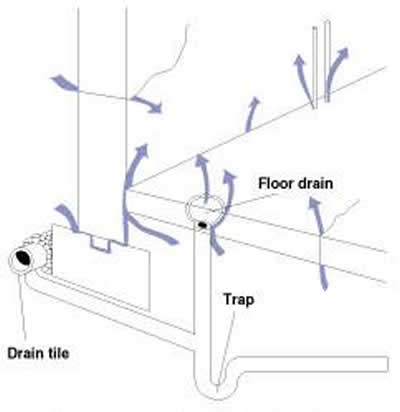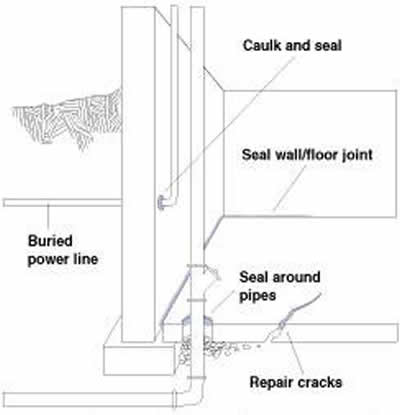Uranium is found in all soils, in varying levels, throughout the world. Radon gas is formed as the uranium decays and is a very natural occurrence.
In some areas the amount of radon gas being expelled from the decaying uranium reaches levels that can be harmful to you and your family.
Even at high levels of concentration the gas is undetectable without using laboratory equipment as the gas itself has no odor, is tasteless and invisible to the naked eye.
As a gas which is emitted from the soil it enters your home through cracks and voids in areas in your home that are in direct contact with the soil.
The quantities of the gas that might be expelled from the soil are relative to numerous factors:

Figure 1: Radon gas entry points into your home.
- Concentration of the gas in the soil around your home.
- Make-up of the soil material.
- How the home was constructed.
- The amount of air that circulates between the interior and exterior of the home.
- Ambient temperature.
The most common entry points in a home are (Figure 1):
- Cracks in basement walls.
- Cracks in basement floors,
- Floor drains.
- Groundwater.
If your home uses a well on the property, and the soil contains a high level of Radon gas, it is possible that Radon gas is entering the home through the water pipes.
A common misconception is that high levels of Radon gas can be emitted from some basic building materials such as brick, concrete and stone. Laboratory testing has proven that the amount of Radon Gas emitted from these basic building materials is negligible and on their own pose no health problems.

Figure 2 - Potential Radon Gas Entry Points That Should Be Sealed.

Figure 3 - Professional radon test kit

Figure 4 - Home radon test kit
There is little that can be done to change the quantity or release rate of the soil that your home sits on. The best remediation method is to seal your basement so that the Radon gas does not have any entry points (Figure 2).
It is wise to have your home tested for radon exposure. Testing your home is relatively inexpensive, usually contracted out to an EPA certified contractor. The test involves placing a canister of absorbent material in your home for a week or so, as shown in Figure 3. The canister is then sent to a certified laboratory for analysis. The results of this test determine whether or not the concentrations in the home suggest doing a more detailed test.
You can also purchase home radon test kits
If harmful levels of radon gas are detected in your home it is important that remediation work be undertaken to reduce the amount of radon gas entering your home.
